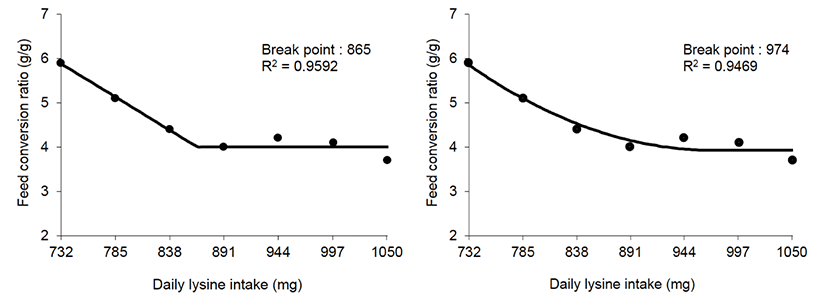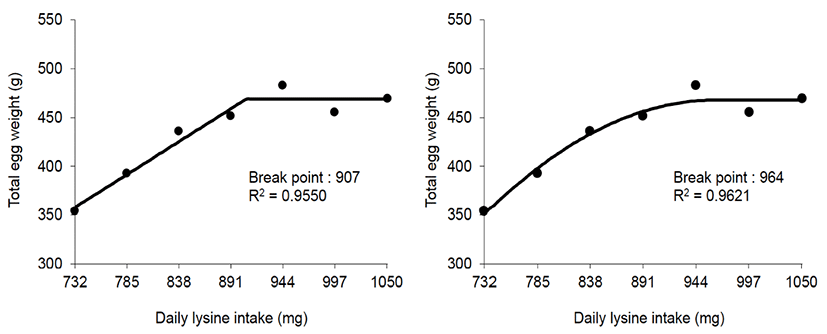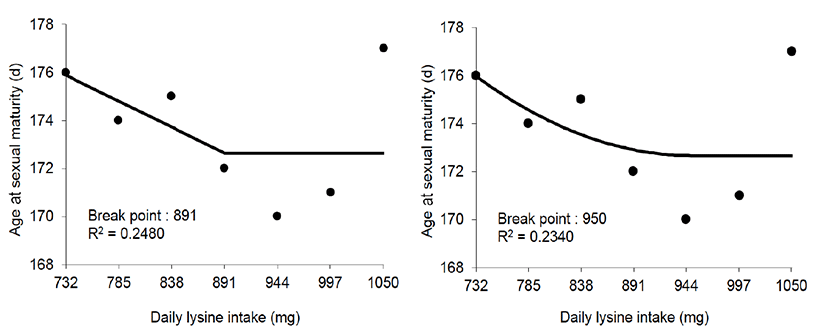INTRODUCTION
It is known that broiler breeders have greater growth potential, and subsequent feed restriction has been recommended to prevent obesity, but to maintain their target body weight for soundly develop their reproductive organs (Robinson and Wilson, 1996; Renema et al., 1999; Tolkamp et al., 2005). In this regard, restricted feed must contain appropriate amount of nutrients for both body growth and reproductive performance. Furthermore, once hens are stimulated by lighting, the reproductive organs maturely grow rapidly, and it is directly associated with their life-time performance.
Lysine is one of the major nutrient in a diet, and could constrict growth-, metabolic-, and physiological-performance of hens, although is the second-limiting amino acid when the diets were formulated based on corn and soybean meals (Edmonds et al., 1985). Moreover, lysine is a reference amino acid (AA) for the ideal AA pattern to maximize productivity of livestock, and to minimize crude protein level in a diet (Baker, 2003). However, the lysine requirement for broiler breeders is still questionable because insufficient studies have been conducted to determine lysine requirement while their genetic growth potential developed rapidly, increased variability among strains, and also improved feed quality and feeding system (Cheema et al., 2003; Havenstein et al., 2003).
The sexual maturity of egg-type chickens depends on critical factors like 1) lightening program (Andrews et al., 1987; Jácome et al., 2014), 2) physical condition (Renema et al., 1999; Ciacciariello and Gous, 2005) and 3) nutrition supply (Miclea et al., 2002; Forte et al., 2016). Broiler breeders are fed restricted rations for the sake of limit weight gain, and thereby have harmony of body growth and sexual maturity to improve laying performance. Kang et al. (2012) demonstrated egg-laying chicken had earlier age at first laying showed higher egg production rate. Nevertheless, the evaluation of lysine requirement based on sexual maturity is scarce in broiler breeders compared to egg-type chickens.
The purpose of the present study was therefore to determine the accurate lysine requirement for improved egg production, efficient utilization of the diet, and minimized age at sexual maturity using linearand quadratic-plateau models. The hypothesis tested in this study was that modern broiler breeder hens’ strains would require higher daily lysine level than NRC (1994) recommendation due to improved genetic potentials.
MATERIALS AND METHODS
The protocol for this study reviewed and approved by Animal Ethics Committee of the Chungnam National University (CNU-00862).
A flock of 126 Ross 308 female broiler breeder hens were selected which achieved the target body weight (2.8 kg) on 21 week of age. Selected birds were allocated in a completely randomized design with seven dietary treatments. Each treatment was consisted 6 replicates with 3 hens per pen. The experiment was started after a 2-week adaptation period and lasted for 6 weeks. The seven treatments were graded daily lysine intake and they were 732, 785, 838, 891, 944, 997 and 1,050 mg per bird per day, respectively.
Birds were managed according to the Ross 308 Parent stock management supplement (2016). Hens were photo-stimulated at 22 week of age; the photoperiod was changed 8-hour light per day to 12-hour light per day. From 23 week of age, all hens fed experimental diets with once a day basis. Experimental diets were iso-caloric and to formulated to meet Ross 308 Parent stock nutrient specification (2016) except for lysine (Table 1). Arginine were followed ideal amino acid pattern to prevent antagonism effect with lysine. The hens fed average 133 g of feed daily throughout the experimental period and fresh water was provided at all times. Feeding space were adequate to prohibit feed competition and allow the birds to easy access.
1 Vitamin-mineral premix provided the following nutrients (per kg of air-dry diet): Vitamins; A 12,000 IU, D 33,000 IU, E 15 mg, K 2 mg, thiamine 2 mg, riboflavin 6 mg, pyridoxine 2 mg, calcium pantothenate 0.03 mg, folic acid 0.2 mg, niacin 45 mg, biotin 0.15 µg. Minerals; calcium 0.5%, Co 0.5 mg (as cobalt sulphate), Cu 10 mg (as copper sulphate), iodine 0.9 mg (as potassium iodine), iron 80 mg (as ferrous sulphate), Mn 80 mg (as manganous oxide), Se 0.2 mg (as sodium selenite), Zn 80 mg (as zinc oxide).
2 The values are calculated according to the values of feedstuffs in NRC (1994).
Body weights of the birds were measured weekly basis to calculate mean body weight and weight gain from 23 to 29 week of age. Pen basis egg production and weight of the eggs were recorded daily. Feed conversion ratio was calculated based on kg of the feed intake and produced egg weight throughout the experiment. Age at sexual maturity was defined as hens attained to age at 25% egg production.
The data from this study were analyzed as a completely randomized design using SPSS software version 24 (IBM SPSS Inc., Chicago, IL, USA). One-way ANOVA was performed using the GLM procedures of SPSS. Levene’s test was applied to test the homogeneity of the variances, then Duncan’s multiple test was applied to determine statistical differences between the means. A value of P<0.05 was considered as statistically significant. For the relationships between variables, Pearson’s rank correlation coefficients were conducted. Linearand quadratic-plateau models were fitted to estimate optimal lysine using the Nutritional Response Model (Version 1.1; Vednov and Pesti, 2008).
RESULTS AND DISCUSSION
To estimate broiler breeders’ daily lysine requirements, linear- and quadratic-plateau models were fitted (Fig. 1∼3) in the current study. Lysine level did not affect mean body weight for 6 weeks (P>0.05; Table 2) and in turn linear- and quadratic-plateau models were failed to fit to the data. Daily lysine requirement for broiler breeder hens from 23 to 29 week of age were estimated to be 865, 891 and 865 mg to minimize feed conversion ratio, the age at sexual maturity and to maximize total produced egg weight, respectively, when data were fitted to a linear-plateau model. However, based on quadratic-plateau model, lysine requirements from 23 to 29 week of age were estimated to be 974, 950 and 964 mg to minimize feed conversion ratio, age at sexual maturity and to maximize total produced egg weight, respectively. The combined values from two models for optimal feed efficiency, sexual maturity and total produced egg weight were to be 916, 921 and 915 mg, respectively.



Our data indicated that quadratic-plateau model resulted in higher lysine requirement than the linear-plateau model. Pesti et al. (2009) reported that linear-broken line model might cause underestimation of nutrient requirement due to the responses of the birds fed dose-response diet are nonlinear, while quadratic-broken line model might abate marginal productivity as far as the requirement is reached.
Fisher (1998) suggested that lysine intake requirement for maximum egg production from 27 to 33 week of age might be 893 mg based on the ‘Reading model’. NRC (1994) recommendations for daily lysine intake in meat-type breeder hens was 765 mg. Harms and Ivey (1992) proposed the total lysine requirement to maximize egg production at 824 mg with a daily protein intake of 18.55 g. Harms and Russell (1995) reported total lysine requirement of 845 mg for maximum egg production, egg mass and egg content when daily intake of 18.07 g protein was provided. One thing we can see that the requirements determined for maximum productivity in the present study (average 925 mg) are considerably higher than those from previous researches. These results closely in accordance with recent results worked by Ekmay et al. (2013), who
suggested 914 mg of digestible lysine was required for maximum product and feed per product ratio from 30 to 32 weeks old broiler breeders using the polynomial regression model. These differences between previous (Harms and Ivey, 1992; Harms and Russell, 1995; Fisher, 1998) and recent studies of lysine requirement could be partially explained improvement of genetic potential in broiler breeders would necessarily require more nutrients (Hayes et al., 2013). The strains with greater growth rate should have higher nutrients needs for their muscle development (Havenstein et al., 2003).
Over growth at a specific age in broiler breeders has been reported likely to be reproductive organs dysfunction such as accumulation of triglyceride in the ovary, follicular dystrophy and multiple ovulation (Chen et al., 2006). As expected, with decreasing lysine level, the age at sexual maturity was delayed in the present study. Moreover, when all hens were used in a ‘Pearson correlation analysis’, age at sexual maturity had negative relationships were observed with total produced egg weight (Table 3; r=—0.565, P<0.001) and feed conversion ratio (r=—954; P<0.001). It can be speculated that all diets could permit maintenance and growth, but not sexual maturity and reproductive performance.
Interestingly, hens fed 1,050 mg of lysine diet showed delayed age at sexual maturity, it may be partially explained by the possible negative impact of in excess of lysine in the diet. Robinson et al. (1993) reported relationship between body growth and reproductive efficiency were interdependent and complementary in broiler breeder hens during laying period. In this light of the possibility, failure in synchronization between growth rate and sexual maturity impeded the age at first-egg laying. However, total produced egg weight in hens fed 1050 mg of lysine diet were nearly covered for delay of sexual maturity in the present study, whereas those fed 732 and 785 mg of lysine diet showed both lower total produced egg weight and delayed sexual maturity.
CONCLUSION
Modern broiler breeders may need more lysine than those recommended in NRC (1994). The different lysine levels in the diets may improve or impede laying performance in broiler breeder hens during early laying period. It is suggested precise dietary lysine level should be served for maximum laying performance in modern broiler breeder strains.








